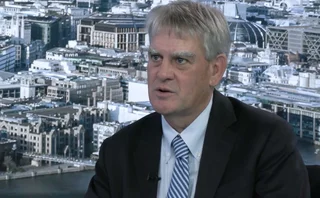
North America house of the year: JP Morgan
Structured Products Americas Awards 2017: Reliable yet innovative US behemoth won over customers and judges with an exceptional second half of the year

The year of 2016 was a game of two halves for JP Morgan. In the first half of the year, market conditions and regulatory uncertainty produced little of consequence; in the second, thanks to an organisational reshuffle and a more propitious climate, the US bank marched to glory in the structured products market.
Over that six-month period, JP Morgan’s pace of retail issuance roughly doubled from its level during the first half of the year. The increase was driven partly by market rebounds but also followed the launch of an issuing entity – JP Morgan Chase Financial – to cope with the imposition of new total loss-absorbing capacity (TLAC) rules. That the novel issuing entity was able to achieve such overnight acceptance by investors is no mean feat.
In brief, the TLAC regulations seek to restrict the amount of non-TLAC debt that can be issued by global systemically important banks. Only a limited amount of non-TLAC debt can be outstanding by the time the rules come into effect on January 1, 2019. As even the most innocuous structured notes – apart from the most lightly structured rate linkers – are categorised as non-TLAC, this left JP Morgan with a problem.
“Through 2015 it was quite apparent that we would have to come up with a way to manage the coming TLAC regulations. It was clear that it would be prudent to have an additional issuing entity for SEC-registered notes,” says Daniel Roose, an executive director in the Americas cross-asset structuring team in New York.
Determining the shape and structure of the new legal entity was no easy task. The bank spent a long time evaluating the framework that would be optimal for itself and its clients, explains Roose. Fully guaranteed by JP Morgan Chase, JP Morgan Chase Financial, whose sole purpose is the issuance of debt, began printing securities in April 2016.
The firm issues only SEC-registered notes, and in 2016 it was the second most-prolific issuer, despite its late start. By the end of the year, it stood behind only UBS and had a 10.87% market share, representing 1,198 notes in all asset classes. In third place was JP Morgan Chase, with a market share of 10.37%.
No-one would argue that 2016 was a halcyon period for the issuance of structured notes, particularly in the rates sector. Interest rates were firmly anchored at the foot of the table for most of the year, until the US election livened things up a little. In the face of a broad decline in the sale of structured notes across the market, JP Morgan’s issuance decreased by 7% while retail sales actually increased by 4%.
“We are committed to the business. We have breadth and depth across asset classes,” says Larry Wilson, the bank’s New York-based managing director in equity derivatives sales for North America.
Our goal is to be consistently relevant to our clients
Larry Wilson, JP Morgan
JP Morgan has been active in the structured notes business in the US for 20 years, and clients are happy to pay testimony to the bank’s strength and consistency.
“Qualitatively, their staff are exceptional and have enjoyed very low turnover, allowing them a deep connectivity with our team; this results in JP Morgan continuously being our ‘gold standard’ in areas like idea generation, service level, etc. It is competitive in virtually every type of structure supporting both our onshore and offshore demand,” says the head of the solutions desk at a tier-one account.
Several clients also noted that the bank seemed to find another gear in 2016. “JP Morgan has expanded its monthly offering from around 20 or 30 deals a few years ago to more than 50 today. Far from adding offerings simply for the sake of it, virtually all of its Cusips represent differentiated ideas and, as a result, garner worthwhile interest,” says one.
For example, despite the crushingly low rates environment last year, the bank remained present and continued to offer new ideas in the structured rates sector. It sold curve steepeners and hybrid steepeners that incorporated equity risk, and was the first bank to bring to the market short-dated yield notes linked to the 10-year constant maturity swap in an SEC-registered offering. These were targeted at buyers of structured equity notes as the payout mirrored those found in the equities market, with features such as reverse exchangeables and phoenix autocalls.
In the fourth quarter, JP Morgan also brought out its first structured note that was eligible as a qualified replacement property (QRP). Owners of retirement plans in the US can avoid the negative tax consequences of selling shares to an employee stock ownership plan if they reinvest the proceeds into a vehicle deemed a QRP.
It is not easy to issue debt that qualifies as a QRP. The rules are complicated and most notes that are issued tend to be long dated in order to maximise tax efficiency. This has restricted the amount of QRP-eligible issuers to a small cast of institutions and has led, in turn, to an unwelcome concentration of credit.
JP Morgan saw the opportunity for new blood in this space. Following extensive internal collaboration and discussions with clients and partners, it printed the $100 million single-tranche issue in October.
The bank demonstrated plenty of innovation during 2016, but it is JP Morgan’s determination to have a strong and nuanced presence across asset classes and products that is perhaps even more worthy of note.
“Our goal is to be consistently relevant to our clients,” stresses Wilson.
Only users who have a paid subscription or are part of a corporate subscription are able to print or copy content.
To access these options, along with all other subscription benefits, please contact info@risk.net or view our subscription options here: http://subscriptions.risk.net/subscribe
You are currently unable to print this content. Please contact info@risk.net to find out more.
You are currently unable to copy this content. Please contact info@risk.net to find out more.
Copyright Infopro Digital Limited. All rights reserved.
As outlined in our terms and conditions, https://www.infopro-digital.com/terms-and-conditions/subscriptions/ (point 2.4), printing is limited to a single copy.
If you would like to purchase additional rights please email info@risk.net
Copyright Infopro Digital Limited. All rights reserved.
You may share this content using our article tools. As outlined in our terms and conditions, https://www.infopro-digital.com/terms-and-conditions/subscriptions/ (clause 2.4), an Authorised User may only make one copy of the materials for their own personal use. You must also comply with the restrictions in clause 2.5.
If you would like to purchase additional rights please email info@risk.net
More on Awards
Collateral management and optimisation product of the year: CloudMargin
Delivering the modern blueprint for enterprise collateral resilience
Flow market-maker of the year: Citadel Securities
Risk Awards 2026: No financing; no long-dated swaps? “No distractions,” says Esposito
Pricing and analytics: fixed income – Quantifi
Quantifi delivers high-performance, transparent and adaptable pricing and risk analytics for fixed income and credit markets
Derivatives house of the year: Citi
Risk Awards 2026: Rev up, RWAs down, as US bank gets back on track (with added XiNG and XiP)
Technology vendor of the year: SS&C Algorithmics
Risk Awards 2026: From cloud, to chips, to maths tricks – vendor getting more out of existing tech
SS&C Algorithmics: winner’s interview with Curt Burmeister
SS&C Algorithmics wins three categories in this year’s Markets Technology Awards in addition to Technology vendor of the year at the Risk Awards
Best vendor for system support and implementation: Murex
Murex wins Best vendor for system support and implementation at the Markets Technology Awards 2026
Pricing and analytics: cross-asset and structured – Murex
Murex wins Pricing and analytics: cross-asset and structured at the Markets Technology Awards 2026 thanks to its MX.3 platform







